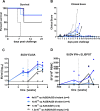A prophylactic multivalent vaccine against different filovirus species is immunogenic and provides protection from lethal infections with Ebolavirus and Marburgvirus species in non-human primates
- PMID: 29462200
- PMCID: PMC5819775
- DOI: 10.1371/journal.pone.0192312
A prophylactic multivalent vaccine against different filovirus species is immunogenic and provides protection from lethal infections with Ebolavirus and Marburgvirus species in non-human primates
Erratum in
-
Correction: A prophylactic multivalent vaccine against different filovirus species is immunogenic and provides protection from lethal infections with Ebolavirus and Marburgvirus species in non-human primates.PLoS One. 2018 Apr 24;13(4):e0196546. doi: 10.1371/journal.pone.0196546. eCollection 2018. PLoS One. 2018. PMID: 29689118 Free PMC article.
Abstract
The search for a universal filovirus vaccine that provides protection against multiple filovirus species has been prompted by sporadic but highly lethal outbreaks of Ebolavirus and Marburgvirus infections. A good prophylactic vaccine should be able to provide protection to all known filovirus species and as an upside potentially protect from newly emerging virus strains. We investigated the immunogenicity and protection elicited by multivalent vaccines expressing glycoproteins (GP) from Ebola virus (EBOV), Sudan virus (SUDV), Taï Forest virus (TAFV) and Marburg virus (MARV). Immune responses against filovirus GP have been associated with protection from disease. The GP antigens were expressed by adenovirus serotypes 26 and 35 (Ad26 and Ad35) and modified Vaccinia virus Ankara (MVA) vectors, all selected for their strong immunogenicity and good safety profile. Using fully lethal NHP intramuscular challenge models, we assessed different vaccination regimens for immunogenicity and protection from filovirus disease. Heterologous multivalent Ad26-Ad35 prime-boost vaccination regimens could give full protection against MARV (range 75%-100% protection) and EBOV (range 50% to 100%) challenge, and partial protection (75%) against SUDV challenge. Heterologous multivalent Ad26-MVA prime-boost immunization gave full protection against EBOV challenge in a small cohort study. The use of such multivalent vaccines did not show overt immune interference in comparison with monovalent vaccines. Multivalent vaccines induced GP-specific antibody responses and cellular IFNγ responses to each GP expressed by the vaccine, and cross-reactivity to TAFV GP was detected in a trivalent vaccine expressing GP from EBOV, SUDV and MARV. In the EBOV challenge studies, higher humoral EBOV GP-specific immune responses (p = 0.0004) were associated with survival from EBOV challenge and less so for cellular immune responses (p = 0.0320). These results demonstrate that it is feasible to generate a multivalent filovirus vaccine that can protect against lethal infection by multiple members of the filovirus family.
Conflict of interest statement
Figures






References
-
- Goeijenbier M, van Kampen JJ, Reusken CB, Koopmans MP, van Gorp EC. Ebola virus disease: a review on epidemiology, symptoms, treatment and pathogenesis. Neth J Med. 2014;72(9): 442–8. - PubMed
-
- World Health Organization. Ebola virus disease. Fact sheet [updated June 2017]. Available from: http://www.who.int/mediacentre/factsheets/fs103/en/
-
- Pigott DM, Golding N, Mylne A, Huang Z, Henry AJ, Weiss DJ, et al. Mapping the zoonotic niche of Ebola virus disease in Africa. eLife. 2014;3: e04395 doi: 10.7554/eLife.04395 - DOI - PMC - PubMed
-
- Pigott DM, Golding N, Mylne A, Huang Z, Weiss DJ, Brady OJ, et al. Mapping the zoonotic niche of Marburg virus disease in Africa. Trans R Soc Trop Med Hyg. 2015;109(6): 366–78. doi: 10.1093/trstmh/trv024 - DOI - PMC - PubMed
-
- International Committee on Taxonomy of Viruses. Virus Taxonomy: 2016 Release. Available from: https://talk.ictvonline.org/taxonomy/
Publication types
MeSH terms
Substances
Grants and funding
LinkOut - more resources
Full Text Sources
Other Literature Sources
Medical

